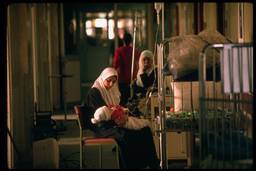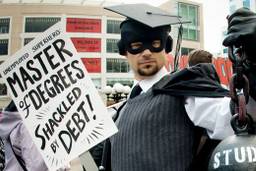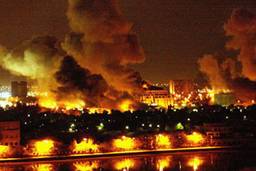Opening the Lines
While federal communications flopped, a small band of wireless technicians helped Katrina victims reconnect with the world
Christopher Hayes

During a September 27 House hearing, discredited ex-FEMA chief and one-time horse-whisperer Michael Brown was asked about the profound failures of communication among those supposedly in charge of responding to Katrina. Many first responders were cut off from communication for days, and local elected officials were reduced to using TV and radio network appearances to communicate with the federal government. What he was supposed to do, he retorted, “Drop a whole phone and radio system into New Orleans, lock, stock and barrel?”
Well, that’s just what Paul Smith and about a dozen fellow wireless technicians did. With just a modest amount of equipment, their all-volunteer team managed to get wireless internet and phone service into a dozen shelters in northern Louisiana in less than a week. Smith is the lead technician for the Chicago-based Center for Neighborhood Technology’s Wireless Community Networks (WCN). The project sets up free wireless “mesh” networks in underserved communities, using inexpensive wireless repeaters, or “nodes,” on rooftops. Using the same WiFi technology found in coffee shops, these nodes can both receive a wireless signal and broadcast it further out; as more nodes are added, the network grows in strength.
A few days after he got back from the Gulf, Smith took an hour to speak with In These Times about the importance of communications during crisis, the rural digital divide and how our corporatist spectrum policies are coming home to roost.
So how’d you end up going down to the Gulf Coast?
Like a lot of people, I was stewing at my desk, obsessively refreshing blogs and getting more and more upset and finally felt like I had to do something with this frustration. I started thinking, ‘What I do know how to do? I know how to set up wireless networks. This is something that there’s going to be a need for. Could we do something?’
[Some friends and I] quickly found out about this guy named Mac Dearman, who had a farm in northeastern Louisiana, well outside the immediate damage from the storm. He ran his own wireless Internet Service Provider (ISP) and immediately after the storm hit, had been going to local shelters and connecting people to the Internet. He told us to come down and he’d put us up in his farm. When we got down there, there was already a bunch of people helping out.
Fellow nerds.
Well, actually, not nerds. Mostly, like, hillbilly wireless guys. These guys were incredible. You look at them and you hear them talk and you think they’re the most stereotypical, redneck, southern guys, but then they start rattling off wireless stats, and it just blows your head. All of these people are charismatic, friendly and brilliant network engineers, many of whom had started their own wireless networks all over the country. They put their lives on hold and converged at Mac’s farm and we all just clicked right away.
Explain to me briefly what a wireless ISP is.
So let’s say, you live in rural Louisiana. Maybe you have dial-up that works but you’re never going to have broadband.
Why not?
Because it doesn’t make economic sense for the telecom companies to physically bury the cable and run it out to these rural communities where there’s just not enough density. I mean, there are places that still don’t have cable TV.
In a lot of ways, these small, independent wireless ISP’s are CNT’s brothers as far as the digital divide goes. They’ve recognized a fundamental need for information and access, and realized that it’s not going to come any other way unless they do it. So there was a really kindred spirit between us and the folks down there, which was good because at first I thought there might be a little bit of a clash.
Like a blue state/red state thing.
Yeah, absolutely, but a lot of people were saying to me that rural communities are left behind just as poor, inner city communities are left behind. It’s just that it takes on a different color. And they’re absolutely right.
So you get down there and then what?
So in these rural communities, there would be 100 to 200 people in the local Baptist church. There’s pretty much a Baptist church every other block, so they have great networks and they’re able to arrange buses and transportation and food. It was, by-and-large, inner city black folks from New Orleans staying in these white Baptist churches. There was no Red Cross and no FEMA; everything was being done by the churches.
When the storm hit, it had knocked out the phone system, even up in northern Louisiana because when I-10 collapsed outside New Orleans, a big chunk of it severed a pipe that was carrying fiber optic cable. Mac was just going to his local church and seeing what they needed and he realized, “Hey, they only have one working telephone. I have a wireless ISP, and my network can carry voice, as well as data, so I’ll take some Laptops and some PCs over, set them up.”
We got down there and came up with a game plan: get the computers ready, get the phones configured and get the wireless gear deployed and just make it happen. We’d go to River of Life Baptist Church, Praise Fellowship Baptist Church, or the Tallulah community center. Tallulah is actually the one that had the biggest impact on me emotionally.
What was it like?
Physically it looks like a gym where they’d have basketball or bake sales. It’s so depressing because it’s not very well lit and just cots from one end to another. Somebody brought them a big screen TV so there’s something breaking up the monotony a little bit. They have the food service on one end. There’s a lot of kids running around and whole families were there too. It would be like: grandma, grandpa, everybody down to grandkids.
There had been reports of violence, and some people in the community were saying you needed to sleep with a crowbar to make sure no one broke into your house and whatnot. But it really wasn’t that way. It’s the same sort of distortion that we saw in the mainstream media, which was that you highlight the handful of people who are doing stupid things. Really, there’s just this unbelievable amount of frustration and desperation and it’s not so easy to characterize that, or to portray it on screen without it seeming like raw hostility.
So, immediately it was clear it wasn’t just about setting up a network and saying “here you go.” Let’s say you’ve never used a computer before or have only a little bit of experience. You’ve been through this event. Your house is gone or possibly gone, you don’t know. You might be separated from your family. And you just want to go to the FEMA Web site to put your name down, where you live, and where you’re at now.
Well, I couldn’t even figure the site out. I had to really sit with it and study it. And then on top of that, we had brought down a lot of computers with Linux on them, and the open-source Web browser Firefox and for 99 percent of what you needed to get to that was fine. Well, the single most important website for evacuees is the FEMA disaster system and it is Internet Explorer 6.0 only. The most insane thing.
So outrageous.
And it’s not even that there was some special feature of Internet Explorer that it needed to access, it was just some lazy programmer somewhere in D.C. ten months ago not thinking people were actually going to have to use this thing. From a usability and accessibility point of view, they just totally dropped the ball. They even have an official federal government guideline that says any Web site that the federal government produces has to be accessible by all screen readers. This is a complete, direct violation at the worst possible time. We lost two days just reformatting and reinstalling for this stupid form.
One of the things we did was grab the young kids at these shelters and say “Hey, you know if you see your mom or dad or somebody who’s a little bit older trying to use the Web site maybe you could help them through it.” In another shelter, there was this enthusiastic guy Lenny, who was really excited about what we were doing and was watching everything. So we said “Why don’t you be the FEMA guy?” He set up a regular schedule so you could sign up for a time slot and Lenny would be there to walk you through the FEMA sign-up.
So people were using the Internet access for the FEMA form and making phone calls to people …
Yeah. We basically set up our own phone network, and after a week, 10,000 outbound calls had been placed through our network.
From the displaced point of view I can’t imagine what it was like to go through all of this and not be able to tell anybody. They didn’t know where they were. I was sitting next to this gentleman as I was working on the computer and he was talking on the phone and getting increasingly agitated: “I don’t know where the hell I am! I am somewhere in Louisiana!” I talked to him later. Until the storm hit, he had never left New Orleans in his life. Information is so critical – knowing what’s going on and where your family is. If we alleviated a small part of that, that’s what we wanted to do.
Let’s talk about the broader lessons: It’s clear to anyone who’s ever been in a situation of panic and confusion how important access to information is during a crisis. Not only did the evacuees have no communications; the people who were in charge in New Orleans didn’t either.
Even the military, the people who forward deploy into supposedly the most hostile places in the world, was struggling to have reliable communication.
The chickens are coming home to roost for our economic policies as far as telecommunications go. I have always believed that telecommunications should be a utility like electricity or water, because it is so fundamental. Instead we have a market system in which we build for today, not for the eventualities of the future.
Right now, the technology exists (and it wouldn’t be resource-intensive) to create a national wireless network that can function in an emergency. But it’s the classic public-sector problem: Creating emergency infrastructure is in no one’s economic self-interest. Think of the Emergency Broadcast Service. No corporation came up with that. What happened was the government stepped in and said, “this is how everyone is going to know what to do in the case of an attack.” Same thing with the Internet. The originating idea behind DARPANET, which was the precursor to the Internet, was a decentralized communications network that could survive a nuclear attack. We need the end-user equivalent of that. If you can pick up your phone and hear a dial tone after a major catastrophe, it’s everything.
Right now, there’s an opportunity to change policy. We need more access to quality spectrum, because right now WiFi requires you to put towers up 50, 60 feet in the air, which takes a lot of time and effort. But if we could broadcast at a lower bandwidth then you could light up the city like that.
And why don’t we have access to that bandwidth?
Because it’s extremely valuable. We refer to it as “beachfront spectrum.” As you go down in the frequency bands, WiFi is at 2.4 GhZ, while network television is at 700MhZ. The TV signal propagates better: it will pass through walls, you don’t have to worry about line of sight. That’s why your TV antennae can pick up the evening news without being in the direct line of site of the network’s broadcast tower.
So the networks have control of the best portion of the spectrum?
Yes, but they shouldn’t for much longer. In the telecommunications bill in the ’90s, the government made a deal. They gave the networks $60 billion worth of free spectrum to broadcast digital television. The quid pro quo was that they’d return the analog TV broadcast band back to the commons. That was the agreement but it’s not happening that way. They’re trying to hang on to it as tight as they can because they know how valuable it is.
Essentially it is a $60 billion dollar theft.
There’s going to be a tooth-and-nail fight to get that back, because it’s exactly that spectrum that we could use to create a robust, redundant, accessible wireless network that would withstand catastrophes like a hurricane or far worse. We need to make the case to the public that the networks are breaking their promise and it means that when the next emergency happens, we’re going to go through the same chaos.







